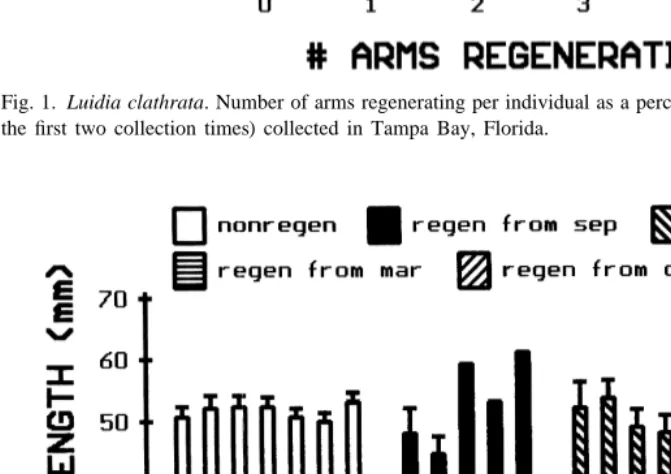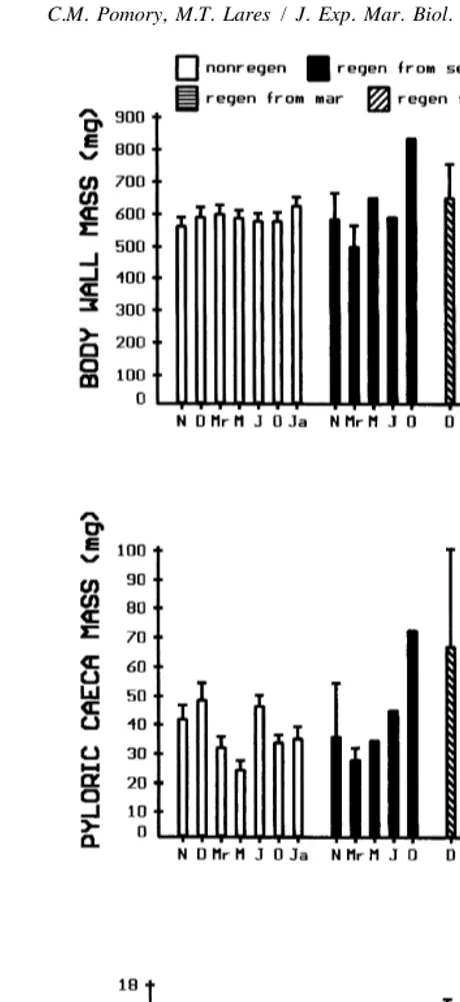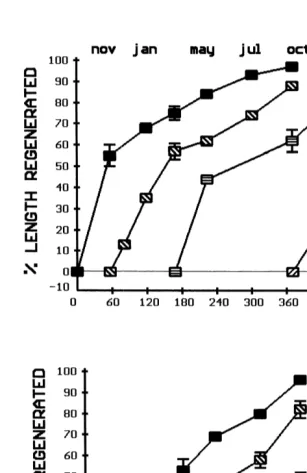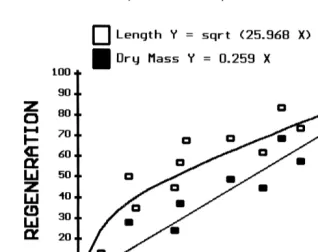254 (2000) 211–220
www.elsevier.nl / locate / jembe
Rate of regeneration of two arms in the field and its effect
on body components in Luidia clathrata
(Echinodermata: Asteroidea)
a ,* b ,1
Christopher M. Pomory , Michael T. Lares
a
Department of Biology, University of South Florida, Tampa, FL, USA
b
Department of Natural Sciences, St. Leo College, St. Leo, FL, USA
Received 2 February 2000; received in revised form 13 July 2000; accepted 11 August 2000
Abstract
The incidence of arm regeneration, effects of arm regeneration on non-regenerating body components and rate of arm regeneration were examined under field conditions. Approximately 60% of Luidia clathrata found in the upper portion of Tampa Bay, Florida were regenerating one or more arms. Individuals with two arms amputated at the disk edge took 380 days to regenerate completely. Both arms of an individual regenerated at the same rate. Length of regenerating arms initially increased faster than dry mass. No difference was found between non-regenerating and regenerating individuals for the dry mass of the body wall, pyloric caeca, and gonad of a non-regenerating arm. The absolute masses of the gonad and pyloric caeca were low through out the year possibly indicating a low food environment. Based on the rate of regeneration, arm loss just prior to the reproductive season may reduce the reproductive potential of this species.
2000 Elsevier Science B.V. All rights reserved.
Keywords: Autotomy; Starfish; Sub-lethal predation
1. Introduction
Arm loss, probably due to predation events, has been reported for a number of asteroids (Lawrence, 1992; Lawrence and Vasquez, 1996). The arms of asteroids contain tube feet (by which they move), pyloric caeca (energy storage and digestive organ), and
*Corresponding author. Present address: Department of Biology, University of West Florida, Pensacola, FL 32514, USA. Tel.: 11-850-857-6028; fax: 11-850-474-2749.
E-mail address: [email protected] (C.M. Pomory).
1
Present address: Department of Mathematics and Sciences, University of Mary, Bismark, North Dakota, 58504-9652, USA.
gonads. Thus, arm loss may lead to a direct reduction in functionality from the standpoint of mobility, energy reserve and reproductive potential. In addition, regenera-tion of lost arms requires resources, which may reduce energy reserves contained in the remaining arms. The magnitude of the effect of arm loss on the individual and population should depend partly on the rate of regeneration. If regeneration is fast then functionality is restored quickly. If it is slow the loss of functionality may have longer-term consequences. No long-term experimental studies of regeneration in asteroids have been conducted in the field, so our knowledge of rates and effects of regeneration is based on laboratory conditions (Lawrence, 1992).
Luidia clathrata is an asteroid found in shallow-water, soft-bottom habitats from the
southern U.S. east coast through the Caribbean region. In laboratory studies on L.
clathrata the regeneration rate, amount of pyloric caeca and gonad increase with
increased food level, and pyloric caeca and gonad production take precedence over regeneration at low food levels (Lawrence et al., 1986; Lawrence and Ellwood, 1991). The purpose of this study was to answer the following questions: (1) What is the incidence of arm regeneration in a population of Luidia clathrata from upper Tampa Bay, Florida? (2) Does regeneration effect pyloric caeca and gonad content of non-regenerating arms? As regeneration requires energetic resources, we hypothesize that regenerating individuals should have lower amounts than non-regenerating individuals. (3) How much time is required for arm regeneration under field conditions? We know of no other field study from which to make a prediction of possible rates, but based on laboratory studies the amount of time should be on the order of several months.
2. Materials and methods
Luidia clathrata were collected by hand from an area (approximately 203100 m, 2–3 m depth) in upper Tampa Bay, Florida, USA in September, November, December 1996, January, March, May, July, October 1997, and January 1998. A total of 6133 individuals were collected over the entire time period. Four experimental ‘‘cohorts’’
were started from collections made in September 1996 (n5644), November 1996
(n5684), March 1997 (n5872) and October 1997 (n51245) by amputating two
adjacent arms at the disk edge with scissors and returning the individuals to the collection area.
Based on the first 1200 individuals collected from the field, arm amputation of two adjacent arms at the disk edge produced a unique pattern allowing for identification of experimental individuals. Since several months were allowed between the start of experimental cohorts, the amount of regeneration fell into discrete size categories that could be used to distinguish the four cohorts over time. Recaptured individuals were removed from the field, so were only sampled once.
Table 1
Luidia clathrata: number of recaptures per cohort (September 1996, November 1996, March 1997, October 1997) at each collection date (September 1996–January 1998)
Cohort Date
Sep Nov Dec Jan Mar May Jul Oct Jan
Sep – 6 0 3 4 1 1 1 0
Nov – – 3 3 5 7 4 5 0
Mar – – – – – 15 0 7 3
Oct – – – – – – – – 7
cohorts and time periods (Table 1). Length and dry mass of the body wall, pyloric caeca, and gonad of the whole arms were measured.
Both regenerating arms were removed at the disk edge with scissors from all recaptured (experimental cohorts) individuals and the length and dry mass were measured. Percent regenerated tissue was calculated by dividing the length or mass of the regenerating arms by the length or mass of a whole arm as measured from the disk edge to the tip of the arm within the same individual.
One-way ANOVA was used to compare the lengths and masses of the whole arms between non-regenerating and regenerating individuals at each collection time and among time periods within each cohort when sample sizes where greater than four (Sokal and Rohlf, 1995). Two-way ANOVA was used to compare the amount of regeneration between the two regenerating arms of the same individual for all recaptures across all time periods collectively. Regression was used to calculate prediction equations for percent regenerated length and dry mass over time for all time periods collectively. Variance homogeneity was checked with Bartlett’s test. Normality was checked with an Anderson–Darling test (D’Agostino, 1986). A significance level of
P,0.05 was used for all statistical tests.
3. Results
Approximately 60 percent of the population was regenerating one or more arms (Fig. 1). Two subdivisions were apparent. Individuals regenerating one, two or three arms each made up about 15 percent of the population and those regenerating four or five arms each made up about 6 percent of the population.
No significant difference was found for length, or the dry mass of any component of the whole arms between non-regenerating and regenerating individuals (Figs. 2, 3A–C). No significant difference was found in length, or the dry mass of the body wall and pyloric caeca of the whole arms among time periods within non-regenerating and regenerating cohorts. A significant difference was found in the dry mass of the gonads of the whole arms among time periods and is especially clear for the non-regenerating group (Fig. 3C). Gonads were present in winter to early spring and entirely absent during summer and early fall.
Fig. 1. Luidia clathrata. Number of arms regenerating per individual as a percent of the population (based on the first two collection times) collected in Tampa Bay, Florida.
regenerating arms (two-way ANOVA n575, length F51.63, dry mass F52.63), so the average value of the two arms was used to represent each individual in the regression models. All four regenerating cohorts followed the same trajectory over time with regards to percent regeneration of length (Fig. 4A) and dry mass (Fig. 4B). Based on regression equations, 100 percent regeneration takes 380 days (Fig. 5). Percent length
2
regenerated was curvilinear, while percent dry mass regenerated was linear (r .0.97
for both) over time.
4. Discussion
More than half the population was undergoing regeneration. A fairly large percentage (12%) had extreme damage with four or five arms regenerating. Arm loss is typically attributed to predation (Lawrence and Vasquez, 1996). Incidence of arm loss in asteroid populations ranges from 0 to 86 percent (Lawrence, 1992), so the study population had a high amount of arm loss by comparison with other species.
No difference was detected in the dry mass of any component of a whole arm between regenerating and non-regenerating individuals. Lawrence and Larrain (1994) found lower amounts of pyloric caeca in Stichaster striatus that were regenerating arms. We expected regenerating individuals of L. clathrata to have lower amounts of pyloric caeca or gonad as regeneration is an additional energy expenditure. We offer three possible explanations. First, there may be no effect of regeneration of two arms. A starfish may be able to increase feeding to compensate for energy requirements leaving the gonads and pyloric caeca untouched. Second, the amounts of pyloric caeca and gonad were low during the entire time of the study and may have been beyond the point of being a useful reserve. This may also be related to the first explanation. Third, the sample size of recaptured individuals at any one point in time was small leading to low power of the statistical tests, so an effect may be present that requires a larger return to detect. For our study area and methodology, that would require an initial cohort size of at least 2000 individuals.
Although no difference was found between the groups, the reproductive cycle was evident in both. The gonads reached maximum development in late winter to early spring and were nonexistent in the summer to early fall. Lawrence (1973) and Dehn (1980) found the same reproductive cycle for L. clathrata from this same area from 1970 to 1978.
Fig. 5. Luidia clathrata. Percent regeneration relative to a whole arm by length and dry mass over time from initial arm loss for all cohorts combined.
faster closer to the disk in Linckia diplax. Anderson (1965) found regeneration of pyloric caeca lagged behind regeneration of body wall in Pisaster ochraceus.
Based on laboratory experiments, regeneration rate and the amount of pyloric caeca and gonad in Luidia clathrata increase with increased food level, and at low food levels pyloric caeca and gonad production take precedence over regeneration (Lawrence et al., 1986; Lawrence and Ellwood, 1991). The amounts of pyloric caeca and gonad in L.
clathrata in the present study were low, and in between values given for the starved and
low food treatments of the study of Lawrence et al. (1986). The amount of pyloric caeca and gonad found by Lawrence and Ellwood (1991) in L. clathrata, using high food levels, was two to five times larger than in the present study. This suggests that food availability in the field was low.
and food level found in the laboratory needs further investigation, as it does not seem to translate well to field conditions. It is probable that the general pattern of ‘‘more food equals more regeneration’’ may hold true for this species, but that the amount of regeneration for a specific level of food may be skewed under laboratory conditions.
Since the gonads and pyloric caeca are completely contained in the arms of most asteroids, the loss of one arm in a typical five-armed species constitutes a 20 percent reduction in storage and reproductive potential. This would also be true if parts of several arms were lost instead one complete arm. Luidia clathrata takes several months to regenerate an arm to a size where it contains pyloric caeca and gonads. We have not found a comparable field study on a different species of asteroid, but based on laboratory studies of other species (e.g. Lares and Lawrence, 1994) and arm morphology of L.
clathrata we suggest that L. clathrata regenerates quickly and that most other species would probably be slower. Arm loss that takes place during, or just before, the reproductive season (late winter in this particular case) should reduce reproductive output in the individual for that year. The impact on reproduction in the population would depend on the incidence of arm loss, which was relatively high in this study.
Acknowledgements
We thank Mark Aley for help in the field and laboratory during the entire experiment; Tim Foret, Sophie Hill, Paul Llobet and Renaldo Rios for help with initial collections; and John Lawrence for providing laboratory space and comments on a draft of the
manuscript. [SS]
References
Anderson, J.M., 1965. Studies on the visceral regeneration in sea-stars. II. Regeneration of pyloric caeca in Asteroidea, with notes on the source of cells in regenerating organs. Biol. Bull. 128, 1–23.
D’Agostino, R.B., 1986. Tests for the normal distribution. In: D’Agostino, R.B., Stephens, M.A. (Eds.), Goodness-of-Fit Techniques. Marcel Dekker, New York, pp. 367–419.
Dehn, P.F., 1980. Growth and reproduction in Luidia clathrata (Say) (Echinodermata: Asteroidea). Ph.D. dissertation, University of South Florida, Tampa, Florida.
Edmonson, C., 1935. Autotomy and regeneration in Hawaiian starfishes. Occ. Pap. Bernice P. Bishop Mus. 11, 1–20.
Lares, M.T., Lawrence, J.M., 1994. Nutrient and energy allocation during arm regeneration in Echinaster paucispinus (Clark) (Echinodermata; Asteroidea). J. Exp. Mar. Biol. Ecol. 180, 49–58.
Lawrence, J.M., 1973. Level, content, and caloric equivalents of the lipid, carbohydrate, and protein in the body components of Luidia clathrata (Echinodermata: Asteroidea: Platyasterida) in Tampa Bay. J. Exp. Mar. Biol. Ecol. 11, 263–274.
Lawrence, J.M., 1987. Echinodermata. In: Pandian, T.J., Vernberg, F.J. (Eds.), Animal Energetics. Bivalvia through Reptilia, Vol 2. Academic Press, San Diego, pp. 229–321.
Lawrence, J.M., 1992. Arm loss and regeneration in Asteroidea (Echinodermata). In: Scalera-Liaci, L., `
Canicattı, C. (Eds.), Echinoderm Research 1991. Balkema, Rotterdam, pp. 39–52.
Lawrence, J.M., Klinger, T.S., McClintock, J.B., Watts, S.A., Chen, C.-P., Marsh, A., Smith, L., 1986. Allocation of nutrient resources to body components by regenerating Luidia clathrata (Say) (Ech-inodermata: Asteroidea). J. Exp. Mar. Biol. Ecol. 102, 47–53.
Lawrence, J.M., Larrain, A., 1994. The cost of arm autotomy in the starfish Stichaster striatus. Mar. Ecol. Prog. Ser. 109, 311–313.
Lawrence, J.M., Vasquez, J., 1996. The effect of sublethal predation on the biology of echinoderms. Oceanologica ACTA 19, 431–440.




